Buzzing with menace and sporting a notorious reputation, the bald-faced hornet incites fear in many. Our teams uncover nine compelling reasons to dread the presence of these aggressive aerial predators. From their imposing size to venomous stings, discover why encounters with bald-faced hornets can leave even the bravest souls trembling.
The penned thoughts of the most imaginative writer of scary stories may effectively delve into the darker realms of the netherworld, but there are some horrors in the natural cosmos that are even more terrifying, and they are often overlooked as subjects in tales that chill and thrill.
These anomalies deliver an intense burst of fear and take us down a grotesque labyrinth of primeval thoughts and emotions.
Some insects, like the bald-faced hornet are nasty critters that belong in our most lurid nightmares, but always seem to make an appearance in the cold light of day.
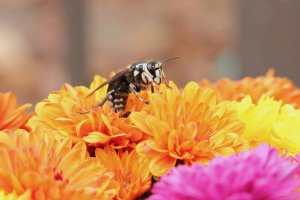
Mother Nature must have had her reasons for creating these fearful insects even though pest control and pest management specialists might secretly question Her motives.
These insects do have their place within the natural order and balance of things, but perhaps Her vision went a bit too far.
The smooth stingers on the bald-faced hornet have the capacity to sting repeatedly with no damage to the insect and much pain to the target (stingee?).
They can inject a large amount of venom into any predator that invades their nest, and this toxic material is often sprayed into the faces, especially the eyes, of any intruder.
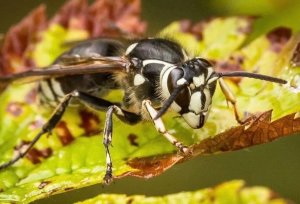
Feel pity for the invaders to one of their enormous colonies, some of which include: skunks, raccoons, and foxes.
These animals rip open their nests to feast upon the larvae and pupae and end up with stings that are unrelentingly painful and itchy and remain so for about 24 hours.
Humans who accidentally venture too close to a hornet’s nest are at the same risk of severe allergic reactions and they can develop Entomophobia, a condition characterized by an obsessive fear of one or more classes of insects, which in the case of the bald-faced hornet, is difficult to eradicate because it is completely justified.
What Is The Bald-Faced Hornet?
Also known as the white-faced hornet, white-tailed hornet, bald-faced yellow jacket, black jacket, and bull wasp, by any name this insect is one that should be avoided at all costs.
This large, black-and-white-colored social wasp is found in Southern Canada and throughout North America.
Although considered a hornet because of its large size and aerial nest, this insect is more closely related to the yellow jacket group.
Habitat And Diet Of The Bald-Faced Hornet
Our pest control expert technicians have often found bald-faced hornet nests along forest edges, in meadows and even in public parks during the full bloom of summer.
Like most stinging insects, they build nests, but they do not reuse them, which is a rather unusual trait among social wasp species.
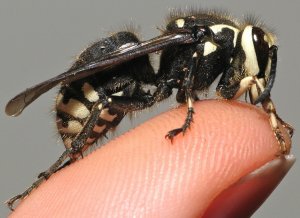
They are carnivorous critters that prey upon other insects, such as spiders and arthropods.
Their diet also includes fruits, meats, tree sap and nectar from flowers.
Although they eat many other insects, their favorite snacks are deer flies and horse flies.
The impact of bald-faced hornets on other insect populations may have great ecological and even human significance.
They in turn often fall prey to many bird species, frogs and praying mantises.
Environmental Implications of the Bald-Faced Hornet
Bald-faced hornets are integral to the balance of nature in their own particular terrifying way. They feed on other insects and in the process of ingesting nectar from flowers may contribute to the pollination of many plants. However, their smooth bodies prevent the adhesion of pollen, rendering them much less effective pollinators than bees.
Nine Reasons To Fear The Bald-Faced Hornet
Each of the following facts individually is disconcerting to say the very least. The presence of bald-faced hornets on any Pittsburgh residential property should initiate an immediate call to our pest control and pest-management specialists!
1) Bald-Faced Hornet’s Nests Are Fearsome
The nest of a bald-faced hornet is an engineering masterpiece.
It begins as a very small structure that grows throughout the summer as the colony gets larger and larger.
Usually situated three or more feet off of the ground in order to prevent attacks from predators like raccoons, these aerial nests are sometimes found in dense branches high in the canopy of a tree.
When built into trees, these structures can be as high as 60 feet above the ground and become almost invisible.
Most people don’t even know they are there until the leaves drop in the fall. Nests are also sometimes attached to shrubs, utility poles or house siding.
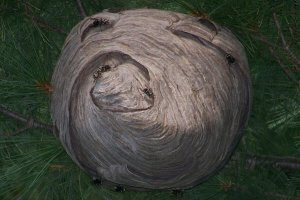
Constructed of multiple layers of hexagonal combs all encased in about two inches of a protective paper-like material made from chewed wood fibers mixed with saliva, these gray nests in Pennsylvania have been known to reach up to 24 inches in height and 18 inches across.
They can contain as many as 700 hornets, which is a formidable number even for the best of expert pest control technicians, who are specially trained to deal with these scary critters.
Nests are usually football-shaped with an opening at the bottom which allows ingress and egress. In addition, there are air vents in the upper portion of the nest that allow excess heat to leave the nest and at the same time provide shelter against the rain.
All of the individuals in the colony are the offspring of the founding Queen.
2) Bald-Faced Hornets Are Very Aggressive
Bald-faced hornets will attack anyone or anything that invades their space, unlike other stinging insects that may only sting when they feel extremely threatened.
They are easily agitated by outside noises and are sensitive to vibrations, which often travel through the air.
For a hapless homeowner innocently mowing a lawn near an overhang that has a bald-faced hornet’s nest, a grim surprise awaits the turn of the next corner that may well result in a trip to the emergency room.
It is recommended that if such occurs, the best thing to do is to move briskly away from the scene and avoid swinging arms and making quick movements.
This is very easy to say and a lot harder to do when confronted with such a threat to bodily harm.
3) The Sting Of A Bald-Faced Hornet Is Wicked
The sting of a bald-faced hornet is truly painful and in the case of some people can cause severe allergic reactions.
Medical attention should be sought immediately if anyone who has been stung experiences difficulty breathing, swelling in the face, throat, or mouth, difficulty swallowing, anxiety, rapid pulse or dizziness.
4) They Have A Very Good Memory
Bald-faced hornets can remember faces, and unfortunately there is no witness protection program to help disguise identity if a human inadvertently returns to the nest area (or from the hornet’s perspective, the scene of the crime).
Once an intruder is within their sights, they will wait with all the patience of a hired hitman for their target to make another visit.
They have been known to fly past other people in order to sting the invader to their nest.
This has implications that go far beyond pain and emergency rooms, as insects are not usually thought to have that kind of social intelligence.
This adds a new and horrifying dimension to their capabilities to harm humans.
According to Reuven Dukas, an evolutionary biologist who studies insect learning at McMaster University in Ontario, Canada: “This quality shows how we used to underestimate insect learning and cognition.The biased view that you need a giant brain to be smart is not fully correct. Animals with small brains can do much more than we used to attribute to them.”
5) Bald-Faced Hornets Prefer Live Prey
Bald faced hornets prefer a diet of insects that die while fighting for their lives. Victims include but are not limited to little insects and flies.
In their own horrible way, they are highly efficient killing machines.
6) Bald-Faced Hornets Love To Eat Bees
Live bees provide protein for their future queens and the sweetness of sugary honey.
Nearly 5 times the size of a typical honey bee, it only takes a small number of giant hornets to wipe out an entire honey bee colony.
It is said that one giant hornet can kill roughly 40 bees a minute. (Put that fact in your thinking cap and smoke it, or something like that.)
In an interesting aside, Japanese honey bees have developed a survival tactic that stops hornets from wiping out their colonies.
As a hornet scout approaches the hive, the honey bees attack it before it can release any pheromones to attract other hornets.
Due to the fact that their stings are no match for the hornets, they swarm around the hornet instead, vibrating their bodies at a tremendous rate, which causes the temperature in the hive to rise drastically, roasting the hornet intruder alive.
It can only be hoped that honey bees from other areas of the globe will discover this defense mechanism.
7) Hornets Are Considered A Delicacy In Japan
Although hornet stings are responsible for a high percentage of hospital visits in Japan, residents get even in a way by snacking on these insects especially in rural mountain villages.
Hornet larvae in particular, either deep fried or raw, is said to provide a huge amount of protein.
The larvae also produce a sticky, sweet compound known as vespa amino acid mixtures (VAAM) which have become a very popular energy drink in Japan.
A new dimension in terrifying thought could include the kind of power hornet energy can transmit to the mean boss or nasty mother-in-law!
8) The Bald Faced Hornet Has Left Its Mark In Hollywood
Many Hollywood films have played on this critter’s fearful reputation.
One John Wayne movie included a scene where a bald-faced hornet nest was thrown into a train.
In the movie, Man of the House, starring Jonathon Taylor Thomas and Chevy Chase, a trap is rigged using a large hornet’s nest that drops onto the bad guys.
9) Bald-Faced Hornets Love Light and Trash Receptacles
Attracted to the light, the best way to get bald-faced hornets out of wherever you happen be is to shut out the lights and open the window with an outside light. (If you can’t find the light switch, you are on your own.)
They also are attracted to poorly maintained trash receptacles and spills, which might provide just the right incentive to keep trash cans closed and properly maintained.
Pittsburgh Hornet And Pest Control Solutions
If the nest is out of the way and does not endanger people, it is probably best to just leave it alone, as their dietary regimens are a boon to gardeners and landscapers.
Bald-faced hornet nest removal becomes necessary, however, if it is close enough to a house that it becomes a threat to residents.
These insects have been known to build nests in hedges, on the sides of houses, underneath carports, inside barns, attics, and even the underside of sturdy patio furniture.
Nest removal is not a do-it-yourself project, or at least it shouldn’t be because such action can aggravate the colony and cause the hornets to sting.
Our professional exterminators are most likely to inspect a nest during daylight hours and return to remove it later in the evening when the majority of the hornets are in their shelter, which maximizes the efficiency of removal.
If you live anywhere throughout Greater Pittsburgh and you think you may have a bald-faced hornet problem, be sure to call our teams, first and foremost!
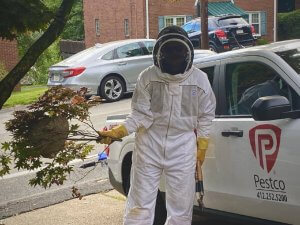
Pestco Control Solutions For Pittsburgh Homes And Businesses
Residential pest control is just one of the many special services we offer.
We’re a family-operated, five-star company that has been in continuous operation since 1948, and in addition to serving homeowner, we also offer pest control, restroom hygiene and air freshener services via out Complete Facility Care program to businesses throughout Greater Pittsburgh and its environs, Western Pennsylvania, Eastern Ohio and the Western Virginia panhandle.
This program offers, under one cost- effective blanket of services, superior pest-control and pest-management services, ambient air-care and air-freshening products supplied by Air-Scent International and superior restroom hygiene services conducted by Enviro-Master Pittsburgh. Commercial space owners should take advantage of this special three-pronged initiative.
Call Pestco today – (412) 252-5200 – for all your pest control and pest management solutions and… Sleep well, dear reader, but away from open windows.
Photo Credits: Pixabay
 Over 300 Reviews
Over 300 Reviews 